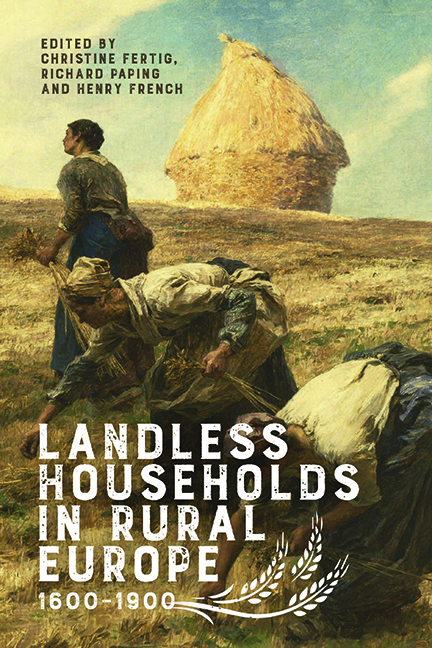Book contents
- Frontmatter
- Contents
- List of Illustrations
- Notes on Contributors
- Preface
- Introduction
- 1 The Treballadors of Girona: Evidence of the Emergence of Wage Labour in Early Modern Catalonia in the Sixteenth and Seventeenth Centuries
- 2 The Squatter Economy of the English Countryside: Building New Landless Communities in England, c. 1600–1900
- 3 The Rise of Landless Households in the Dutch Countryside, c. 1600–1900
- 4 ‘Gaining Ground’ in Flanders after the 1840s: Access to Land and the Coping Mechanisms of Landless and Semi-Landless Households, c. 1850–1900
- 5 Strategies of Survival, Landlessness and Forest Settlement in Flanders: The Forest of Houthulst in a Changing Landscape of Survival (c. 1500–1900)
- 6 Landless and Pauper Households in England, c. 1760–1835: A Comparison of Two Southern English Rural Communities
- 7 Landless Rural Households in France, 1852–1910
- 8 Survival in a Hostile Agrarian Regime: Landless and Semi-Landless Households in Seventeenth-Century Sweden and Finland
- 9 Farming Craftsmen? Access to Land and the Socio-Economic Position of Rural Artisans in Early Modern Finland
- 10 Landlessness and Marriage Restrictions: Tyrol and Vorarlberg in the Eighteenth and Nineteenth Centuries
- 11 Cottages, Barns and Bake Houses: Landless Rural Households in North-Western Germany in the Eighteenth Century
- Bibliography
- Index
- Boydell Studies in Rural History
10 - Landlessness and Marriage Restrictions: Tyrol and Vorarlberg in the Eighteenth and Nineteenth Centuries
Published online by Cambridge University Press: 08 October 2022
- Frontmatter
- Contents
- List of Illustrations
- Notes on Contributors
- Preface
- Introduction
- 1 The Treballadors of Girona: Evidence of the Emergence of Wage Labour in Early Modern Catalonia in the Sixteenth and Seventeenth Centuries
- 2 The Squatter Economy of the English Countryside: Building New Landless Communities in England, c. 1600–1900
- 3 The Rise of Landless Households in the Dutch Countryside, c. 1600–1900
- 4 ‘Gaining Ground’ in Flanders after the 1840s: Access to Land and the Coping Mechanisms of Landless and Semi-Landless Households, c. 1850–1900
- 5 Strategies of Survival, Landlessness and Forest Settlement in Flanders: The Forest of Houthulst in a Changing Landscape of Survival (c. 1500–1900)
- 6 Landless and Pauper Households in England, c. 1760–1835: A Comparison of Two Southern English Rural Communities
- 7 Landless Rural Households in France, 1852–1910
- 8 Survival in a Hostile Agrarian Regime: Landless and Semi-Landless Households in Seventeenth-Century Sweden and Finland
- 9 Farming Craftsmen? Access to Land and the Socio-Economic Position of Rural Artisans in Early Modern Finland
- 10 Landlessness and Marriage Restrictions: Tyrol and Vorarlberg in the Eighteenth and Nineteenth Centuries
- 11 Cottages, Barns and Bake Houses: Landless Rural Households in North-Western Germany in the Eighteenth Century
- Bibliography
- Index
- Boydell Studies in Rural History
Summary
Agrarian milieus, landownership and landowners have, for the most part, been the main focus of historical research in the rural context. The land-poor and landless, on the other hand, have been the subjects of far less research – despite their numbers rising significantly in most European countries during the eighteenth and nineteenth centuries. This rise was connected with the increase of proto-industrial production, with declines in wages, with agrarian structures dominated by small units of agricultural production or based on day labour, and with agricultural crises and agricultural reforms. In Prussia, for example, the landless and land-poor accounted for one-third of the population during the mid-nineteenth century. Research on proto-industrialisation has generated significant interest in those whose tenancy placed them in a fixed relationship with landowning peasants. Among this group were the so-called Heuerlinge – who were regularly forced to renegotiate the conditions under which they secured their livelihoods. Comprehensive research on agricultural labourers has been conducted by Craig Muldrew, and impulses for further research in this area might find a home in the diverse forms of mixed economies5 and shadow economies that existed at the time, as well as the new attention being paid to pluriactivity. Thomas Piketty's widely discussed findings in Capital in the Twenty-First Century give wealth – particularly inherited wealth – new prominence in the debate as a necessary complement to the focus on income. This approach could also be fruitful for the topic of landlessness, as could the nuances that are a feature of newer research on poverty to which Steven King has recently referred: how one must assume a broad spectrum of people were affected, how attention should be directed to specific contexts and situations that generate poverty, and how one must always consider the matter of agency, in the sense of an ability to negotiate.8 Thus, the status of landless and land-poor people needs to be viewed not as permanent, but as situational and partly compensated by specific skills – even if it did frequently become firmly established.
The landless and land-poor should not be considered under the a priori assumption that they were a clearly defined group or even an established social class.
- Type
- Chapter
- Information
- Landless Households in Rural Europe, 1600-1900 , pp. 243 - 269Publisher: Boydell & BrewerPrint publication year: 2022

